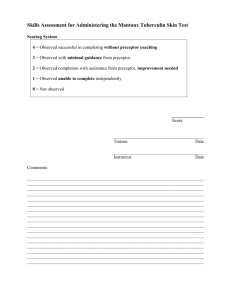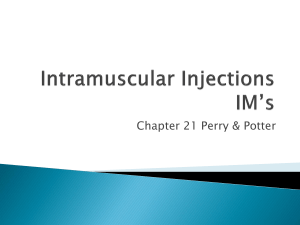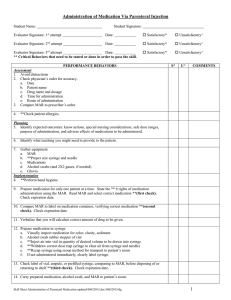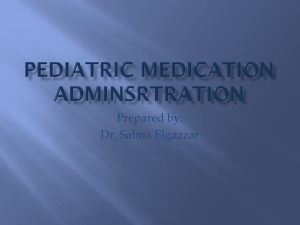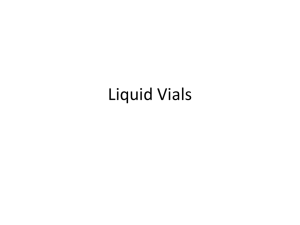Skill Checklists to Accompany Fundamentals of Nursing: The Art and
advertisement
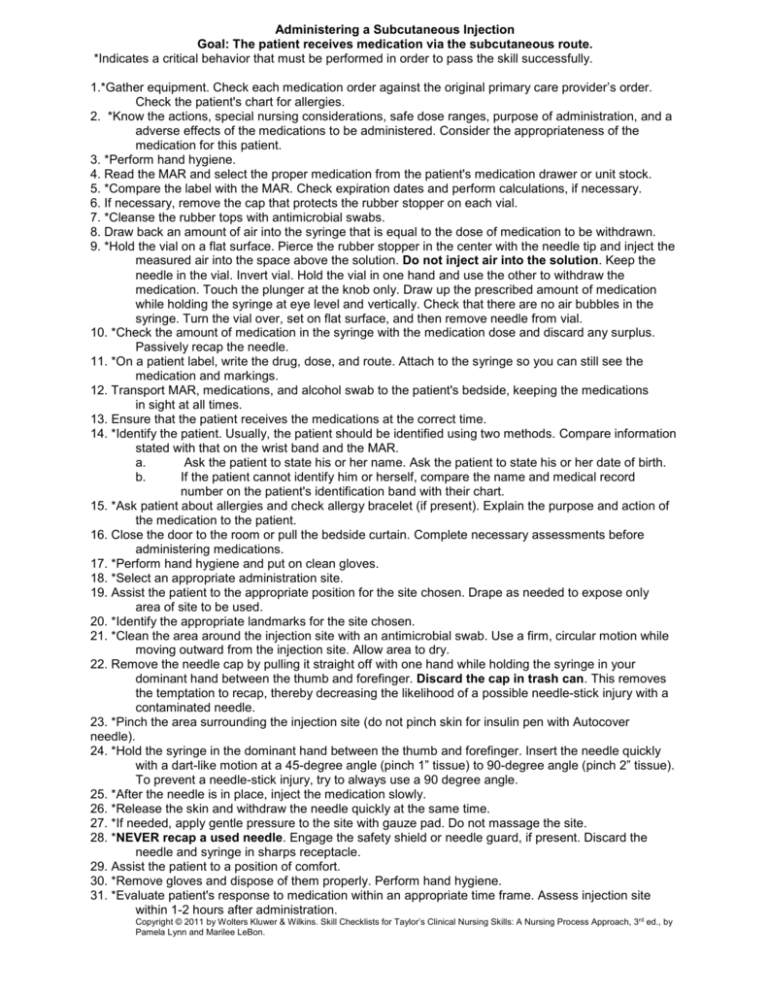
Administering a Subcutaneous Injection Goal: The patient receives medication via the subcutaneous route. *Indicates a critical behavior that must be performed in order to pass the skill successfully. 1.*Gather equipment. Check each medication order against the original primary care provider’s order. Check the patient's chart for allergies. 2. *Know the actions, special nursing considerations, safe dose ranges, purpose of administration, and a adverse effects of the medications to be administered. Consider the appropriateness of the medication for this patient. 3. *Perform hand hygiene. 4. Read the MAR and select the proper medication from the patient's medication drawer or unit stock. 5. *Compare the label with the MAR. Check expiration dates and perform calculations, if necessary. 6. If necessary, remove the cap that protects the rubber stopper on each vial. 7. *Cleanse the rubber tops with antimicrobial swabs. 8. Draw back an amount of air into the syringe that is equal to the dose of medication to be withdrawn. 9. *Hold the vial on a flat surface. Pierce the rubber stopper in the center with the needle tip and inject the measured air into the space above the solution. Do not inject air into the solution. Keep the needle in the vial. Invert vial. Hold the vial in one hand and use the other to withdraw the medication. Touch the plunger at the knob only. Draw up the prescribed amount of medication while holding the syringe at eye level and vertically. Check that there are no air bubbles in the syringe. Turn the vial over, set on flat surface, and then remove needle from vial. 10. *Check the amount of medication in the syringe with the medication dose and discard any surplus. Passively recap the needle. 11. *On a patient label, write the drug, dose, and route. Attach to the syringe so you can still see the medication and markings. 12. Transport MAR, medications, and alcohol swab to the patient's bedside, keeping the medications in sight at all times. 13. Ensure that the patient receives the medications at the correct time. 14. *Identify the patient. Usually, the patient should be identified using two methods. Compare information stated with that on the wrist band and the MAR. a. Ask the patient to state his or her name. Ask the patient to state his or her date of birth. b. If the patient cannot identify him or herself, compare the name and medical record number on the patient's identification band with their chart. 15. *Ask patient about allergies and check allergy bracelet (if present). Explain the purpose and action of the medication to the patient. 16. Close the door to the room or pull the bedside curtain. Complete necessary assessments before administering medications. 17. *Perform hand hygiene and put on clean gloves. 18. *Select an appropriate administration site. 19. Assist the patient to the appropriate position for the site chosen. Drape as needed to expose only area of site to be used. 20. *Identify the appropriate landmarks for the site chosen. 21. *Clean the area around the injection site with an antimicrobial swab. Use a firm, circular motion while moving outward from the injection site. Allow area to dry. 22. Remove the needle cap by pulling it straight off with one hand while holding the syringe in your dominant hand between the thumb and forefinger. Discard the cap in trash can. This removes the temptation to recap, thereby decreasing the likelihood of a possible needle-stick injury with a contaminated needle. 23. *Pinch the area surrounding the injection site (do not pinch skin for insulin pen with Autocover needle). 24. *Hold the syringe in the dominant hand between the thumb and forefinger. Insert the needle quickly with a dart-like motion at a 45-degree angle (pinch 1” tissue) to 90-degree angle (pinch 2” tissue). To prevent a needle-stick injury, try to always use a 90 degree angle. 25. *After the needle is in place, inject the medication slowly. 26. *Release the skin and withdraw the needle quickly at the same time. 27. *If needed, apply gentle pressure to the site with gauze pad. Do not massage the site. 28. *NEVER recap a used needle. Engage the safety shield or needle guard, if present. Discard the needle and syringe in sharps receptacle. 29. Assist the patient to a position of comfort. 30. *Remove gloves and dispose of them properly. Perform hand hygiene. 31. *Evaluate patient's response to medication within an appropriate time frame. Assess injection site within 1-2 hours after administration. Copyright © 2011 by Wolters Kluwer & Wilkins. Skill Checklists for Taylor’s Clinical Nursing Skills: A Nursing Process Approach, 3rd ed., by Pamela Lynn and Marilee LeBon.

